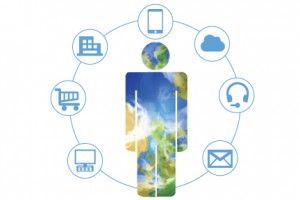This is the first in a series of blogs that will showcase methodical approaches to digital business transformation.
If you think we’re headed for an all-digital nirvana, I suggest you think again. I believe paper will always be around and will continue to be essential in conducting business, in combination with digital approaches. I was tempted to write a blog called “How paper is the solution to cyber-attacks,” but a more sober-minded me took control, at least for now. But you get the idea; I don’t buy into the myth that paperless (aka all-digital) is the ideal we should be reaching for.
This disclaimer is important because it helps explain why I am wary of the notion that all we need to do is find the “paper” in every system or process and convert it to some digital equivalent. If this thinking were valid for information architectures, all we would need to do is convert analog/physical to digital formats, digitize all processes and build e-business environments that handle all transactions with no human interaction.
There is value to this thinking, but it’s not enough, not when you are tasked to build architectures that can be sustained beyond one week. When you hear a project leader say, “all we need to do is,” run for the hills.
 Consider an example from the retail industry. The era of e-business brought a new lexicon of terms such as e-commerce (aka online shopping) and brick-and-mortar (aka retail stores). A whole generation of architects (the ones who had computer chips in their toys and laptops in pre-kindergarten) grew up with Java, HTML and the belief that shopping means digital. Surely everyone will do all their shopping online using Paypal. They figure that e-commerce systems don’t need to consider that other, outmoded form of shopping, with its point-of-sales systems and brick-and-mortar stores. They cite companies such as Netflix and Amazon as proof that, if we’re not there yet, we will be soon.
Consider an example from the retail industry. The era of e-business brought a new lexicon of terms such as e-commerce (aka online shopping) and brick-and-mortar (aka retail stores). A whole generation of architects (the ones who had computer chips in their toys and laptops in pre-kindergarten) grew up with Java, HTML and the belief that shopping means digital. Surely everyone will do all their shopping online using Paypal. They figure that e-commerce systems don’t need to consider that other, outmoded form of shopping, with its point-of-sales systems and brick-and-mortar stores. They cite companies such as Netflix and Amazon as proof that, if we’re not there yet, we will be soon.
Not so fast.
What about Redbox and other companies that reach customers through self-serve kiosks combined with e-commerce? What about companies like Chico’s that skillfully cultivate in-store relationships through online interactions and vice versa?
According to research by the global management consulting firm, A.T. Kearney, “it’s not physical or digital; it’s physical with digital” that will deliver value, since 90 percent of sales are still transacted in physical stores, and customers often visit stores before making an online purchase. Gartner defines digital business as “the creation of new business designs by blurring the digital and physical worlds.”
According to Accenture research, 68 percent of millennials demand an integrated, seamless experience across physical and digital channels, from smartphone to personal computer to physical stores. Yes, they’re shopping in stores. Just go to any mall on Saturday and see for yourself.
The implications are clear. Digital business transformation has to be more than just going digital.
Solution architects must balance the physical and digital worlds. Think omnichannel rather than multi-channel. It’s about creating seamless experiences for customers, no matter where they are or how they are engaging with the company. Those customers/patients/suppliers/partners/stakeholders expect to get personalized information or offers in the right format, at the right time, with full awareness of their context and preferences.
Obviously, this is way beyond converting static paper reports into Excel spreadsheets, or running an enterprise resource planning (ERP) system or using analytics for more precise target marketing. It is about bringing together a constellation of data points from inside and outside the organization to support new intelligence and new business models.
In the next part of this series, we will delve more deeply into how the push for digital business transformation is changing the way we think about software architectures in terms of interconnections.
Very interesting opinion because most articles I have read on digital transformation believe paperless is the main goal. Good insight and look forward to reading more in your series.
Janice, thank you. I am glad you found a different perspective helpful. Do stay tuned for the next in the series.
Very good insight and clearly a reality check that while there are many things that need to be digitized for efficiency, cost control, faster time to market and most importantly, extending opportunities to previously hard to reach locations, one must blend the “old way of doing things” with the new.
Marcus, thank you for your comments. I could not agree more, we must find ways to blend old ways, sometimes they are still good ways to get things done.
James, this is a very nice blog article; I truly like the “down to earth” way of thinking – we need more of this to help combine the the new way and the old world work as a perfect match! Looking forward to more…